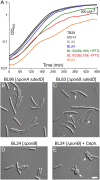Roles of the DedD Protein in Escherichia coli Cell Constriction
- PMID: 30692172
- PMCID: PMC6436348
- DOI: 10.1128/JB.00698-18
Roles of the DedD Protein in Escherichia coli Cell Constriction
Abstract
Two key tasks of the bacterial septal-ring (SR) machinery during cell constriction are the generation of an inward-growing annulus of septal peptidoglycan (sPG) and the concomitant splitting of its outer edge into two layers of polar PG that will be inherited by the two new cell ends. FtsN is an essential SR protein that helps trigger the active constriction phase in Escherichia coli by inducing a self-enhancing cycle of processes that includes both sPG synthesis and splitting and that we refer to as the sPG loop. DedD is an SR protein that resembles FtsN in several ways. Both are bitopic inner membrane proteins with small N-terminal cytoplasmic parts and larger periplasmic parts that terminate with a SPOR domain. Though absence of DedD normally causes a mild cell-chaining phenotype, the protein is essential for division and survival of cells with limited FtsN activity. Here, we find that a small N-terminal portion of DedD (NDedD; DedD1-54) is required and sufficient to suppress ΔdedD-associated division phenotypes, and we identify residues within its transmembrane domain that are particularly critical to DedD function. Further analyses indicate that DedD and FtsN act in parallel to promote sPG synthesis, possibly by engaging different parts of the FtsBLQ subcomplex to induce a conformation that permits and/or stimulates the activity of sPG synthase complexes composed of FtsW, FtsI (PBP3), and associated proteins. We propose that, like FtsN, DedD promotes cell fission by stimulating sPG synthesis, as well as by providing positive feedback to the sPG loop.IMPORTANCE Cell division (cytokinesis) is a fundamental biological process that is incompletely understood for any organism. Division of bacterial cells relies on a ring-like machinery called the septal ring or divisome that assembles along the circumference of the mother cell at the site where constriction eventually occurs. In the well-studied bacterium Escherichia coli, this machinery contains over 30 distinct proteins. We identify functionally important parts of one of these proteins, DedD, and present evidence supporting a role for DedD in helping to induce and/or sustain a self-enhancing cycle of processes that are executed by fellow septal-ring proteins and that drive the active constriction phase of the cell division cycle.
Keywords: FtsA; FtsB; FtsL; FtsQ; cell division.
Copyright © 2019 American Society for Microbiology.
Figures








Similar articles
-
Regulation of the Peptidoglycan Polymerase Activity of PBP1b by Antagonist Actions of the Core Divisome Proteins FtsBLQ and FtsN.mBio. 2019 Jan 8;10(1):e01912-18. doi: 10.1128/mBio.01912-18. mBio. 2019. PMID: 30622193 Free PMC article.
-
Self-enhanced accumulation of FtsN at Division Sites and Roles for Other Proteins with a SPOR domain (DamX, DedD, and RlpA) in Escherichia coli cell constriction.J Bacteriol. 2009 Dec;191(24):7383-401. doi: 10.1128/JB.00811-09. Epub 2009 Aug 14. J Bacteriol. 2009. PMID: 19684127 Free PMC article.
-
FtsA acts through FtsW to promote cell wall synthesis during cell division in Escherichia coli.Proc Natl Acad Sci U S A. 2021 Aug 31;118(35):e2107210118. doi: 10.1073/pnas.2107210118. Proc Natl Acad Sci U S A. 2021. PMID: 34453005 Free PMC article.
-
E. coli Cell Cycle Machinery.Subcell Biochem. 2017;84:27-65. doi: 10.1007/978-3-319-53047-5_2. Subcell Biochem. 2017. PMID: 28500522 Review.
-
An Updated Model of the Divisome: Regulation of the Septal Peptidoglycan Synthesis Machinery by the Divisome.Int J Mol Sci. 2022 Mar 24;23(7):3537. doi: 10.3390/ijms23073537. Int J Mol Sci. 2022. PMID: 35408901 Free PMC article. Review.
Cited by
-
Cell Cycle-Dependent Recruitment of FtsN to the Divisome in Escherichia coli.mBio. 2022 Aug 30;13(4):e0201722. doi: 10.1128/mbio.02017-22. Epub 2022 Aug 15. mBio. 2022. PMID: 35968943 Free PMC article.
-
Recruitment of the TolA Protein to Cell Constriction Sites in Escherichia coli via Three Separate Mechanisms, and a Critical Role for FtsWI Activity in Recruitment of both TolA and TolQ.J Bacteriol. 2022 Jan 18;204(1):e0046421. doi: 10.1128/JB.00464-21. Epub 2021 Nov 8. J Bacteriol. 2022. PMID: 34748387 Free PMC article.
-
Cell division is antagonized by the activity of peptidoglycan endopeptidases that promote cell elongation.Mol Microbiol. 2020 Dec;114(6):966-978. doi: 10.1111/mmi.14587. Epub 2020 Aug 31. Mol Microbiol. 2020. PMID: 32866331 Free PMC article.
-
Genetic requirements for uropathogenic E. coli proliferation in the bladder cell infection cycle.mSystems. 2024 Oct 22;9(10):e0038724. doi: 10.1128/msystems.00387-24. Epub 2024 Sep 17. mSystems. 2024. PMID: 39287381 Free PMC article.
-
A Dynamic Network of Proteins Facilitate Cell Envelope Biogenesis in Gram-Negative Bacteria.Int J Mol Sci. 2021 Nov 27;22(23):12831. doi: 10.3390/ijms222312831. Int J Mol Sci. 2021. PMID: 34884635 Free PMC article. Review.
References
Publication types
MeSH terms
Substances
Grants and funding
LinkOut - more resources
Full Text Sources
Molecular Biology Databases
Research Materials

